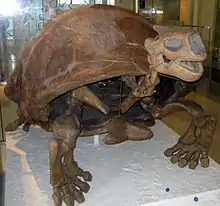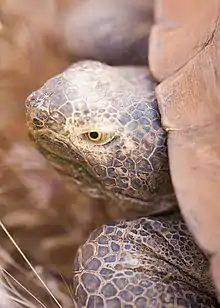Megalochelys
Megalochelys is an extinct genus of cryptodiran tortoises that lived from the Miocene to Pleistocene, across Asia and possibly Eastern Europe. They are noted for their giant size, which is among the largest of any known testudine, with a maximum carapace length over 2 m (6.5 ft) in M. atlas.
| Megalochelys | |
|---|---|
 | |
| M. atlas skeleton at the American Museum of Natural History | |
| Scientific classification | |
| Kingdom: | Animalia |
| Phylum: | Chordata |
| Class: | Reptilia |
| Order: | Testudines |
| Suborder: | Cryptodira |
| Superfamily: | Testudinoidea |
| Family: | Testudinidae |
| Genus: | †Megalochelys Falconer & Cautley, 1837[1][2] |
| Synonyms | |
This fossil genus is the original and valid name for what has been called Colossochelys. It contains three named species with several unnamed taxa.[1]
- Megalochelys atlas Falconer and Cautley, 1844[1][3] Late Pliocene to Early Pleistocene, India (Sivalik Hills), Myanmar, ?Thailand
- Megalochelys cautleyi Lydekker, 1889[1][4] Late Pliocene to Early Pleistocene), India (Sivalik Hills) probable nomen dubium.[5]
- Megalochelys margae[1] Early Pleistocene until 2 million years ago (Mya) Sulawesi, Indonesia
- Megalochelys sondaari Karl and Staesche, 2007 [1][6] Early Pleistocene (until 1.7 ma) Luzon, Philippines
- Megalochelys sp. Middle-Late Pleistocene (about 0.8-0.12 Mya) Timor, Indonesia[5]
- Megalochelys sp. Early Pleistocene (until 1.2 Mya) Java, Indonesia[5]
- Megalochelys sp. Early Pleistocene (until 0.9 Mya) Flores, Indonesia[5]
Extinction
The genus is highly suspected to have gone extinct due to the arrival of Homo erectus, due to staggered extinctions on islands coinciding with the arrival of H. erectus in these regions, as well as evidence of exploitation by H. erectus.[5] The genus was largely extinct by the end of the Early Pleistocene, but persisted on Timor into the Middle Pleistocene.
References
- Rhodin, A.G.J.; Thomson, S.; Georgalis, G.; Karl, H.-V.; Danilov, I.G.; Takahashi, A.; de la Fuente, M.S.; Bourque, J.R.; Delfino M.; Bour, R.; Iverson, J.B.; Shaffer, H.B.; van Dijk, P.P.; et al. (Turtle Extinctions Working Group) (2015). "Turtles and tortoises of the world during the rise and global spread of humanity: first checklist and review of extinct Pleistocene and Holocene chelonians" (PDF). Chelonian Research Monographs. 5(8):000e.1–66. doi:10.3854/crm.5.000e.fossil.checklist.v1.2015. Archived from the original (PDF) on 2019-07-18. Retrieved 2019-10-15.
- Falconer, H. and Cautley, P.T. 1837. On additional fossil species of the order Quadrumana from the Siwalik Hills. Journal of the Asiatic Society of Bengal 6:354–360.
- Falconer, H. and Cautley, P.T. 1844. Communication on the Colossochelys atlas, a fossil tortoise of enormous size from the Tertiary strata of the Siwalk Hills in the north of India. Proceedings of the Zoological Society of London 1844(12):54–84.
- Lydekker, R. 1889. Catalogue of the Fossil Reptilia and Amphibia in the British Museum. Part III. Chelonia. London: British Museum of Natural History, 239 pp.
- Rhodin, Anders; Pritchard, Peter; van Dijk, Peter Paul; Saumure, Raymond; Buhlmann, Kurt; Iverson, John; Mittermeier, Russell, eds. (2015-04-16). Conservation Biology of Freshwater Turtles and Tortoises. Chelonian Research Monographs. 5 (First ed.). Chelonian Research Foundation. doi:10.3854/crm.5.000e.fossil.checklist.v1.2015. ISBN 978-0-9653540-9-7.
- Anders G.J. Rhodin; Scott Thomson; Georgios L. Georgalis; Hans-Volker Karl; Igor G. Danilov; Akio Takahashi; Marcelo S. de la Fuente; Jason R. Bourque; Massimo Delfino; Roger Bour; John B. Iverson; H. Bradley Shaffer; Peter Paul van Dijk (2015). "Turtles and Tortoises of the World During the Rise and Global Spread of Humanity: First Checklist and Review of Extinct Pleistocene and Holocene Chelonians" (PDF). Chelonian Research Monographs. 5 (8): 000e.1–66. doi:10.3854/crm.5.000e.fossil.checklist.v1.2015.
